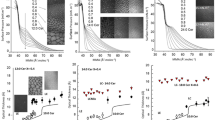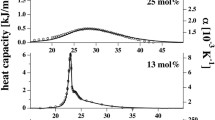Abstract
The phase behaviour of mixed molecular species of phosphatidylethanolamine, phosphatidylserine and sphingomyelin of biological origin were examined in aqueous co-dispersions using synchrotron X-ray diffraction. The co-dispersions of phospholipids studied were aimed to model the mixing of lipids populating the cytoplasmic and outer leaflets in the resting or “scrambled” activated cell membrane. Mixtures enriched with phosphatidylethanolamine and phosphatidylserine were characterized by a phase separation of non-lamellar phases (cubic and inverted hexagonal) with a lamellar gel phase comprising the most saturated molecular species. Inclusion of sphingomyelin in the mixture resulted in a suppression of the hexagonal-II phase in favour of lamellar phases at temperatures where a proportion of the phospholipid was fluid. The effect was also dependent on the total amount of sphingomyelin in ternary mixtures, and the lamellar phase dominated in mixtures containing more than 30 mol%, irrespective of the relative proportions of phosphatidylserine/sphingomyelin. A transition from gel to liquid-crystal phase was detected by wide-angle scattering during heating scans of ternary mixtures enriched in sphingomyelin and was shown by thermal cycling experiments to be coupled with a hexagonal-II phase to lamellar transition. In such samples there was evidence of a coexistence of non-lamellar phases with a lamellar gel phase. A transition of the gel phase to the fluid state on heating from 35 to 41 °C was evidenced by a progressive increase in the lamellar d-spacing. The presence of calcium enhanced the phase separation of a lamellar gel phase from a hexagonal-II phase in mixtures enriched in phosphatidylserine. This effect was counteracted by charge screening with 150 mM NaCl. The effect of sphingomyelin on stabilizing the lamellar phase is discussed in the context of an altered composition in the cytoplasmic/outer leaflets of the plasma membrane resulting from scrambling of the phospholipid distribution. The results suggest that a lamellar structure can be retained by the inward translocation of sphingomyelin in biological membranes. The presence of monovalent cations serves also to stabilize the bilayer in activated cells where a translocation of aminoglycerophospholipids and an influx of calcium occur simultaneously.





Similar content being viewed by others
Abbreviations
- PC:
-
phosphatidylcholine
- PE:
-
phosphatidylethanolamine
- PS:
-
phosphatidylserine
- SAXS:
-
small-angle X-ray scattering
- SM:
-
sphingomyelin
- WAXS:
-
wide-angle X-ray scattering
- XRD:
-
X-ray diffraction
References
Arnold K, Losche A, Gawrisch K (1981) 31P-NMR investigations of phase separation in phosphatidylcholine/phosphatidylethanolamine mixtures. Biochim Biophys Acta 645:143–148
Bally MB, Tilcock CP, Hope MJ, Cullis PR (1983) Polymorphism of phosphatidylethanolamine-phosphatidylserine model systems: influence of cholesterol and Mg2+ on Ca2+-triggered bilayer to hexagonal (HII) transitions. Can J Biochem Cell Biol 61:346–352
Barenholz Y, Thompson TE (1999) Sphingomyelin: biophysical aspects. Chem Phys Lipids 102:29–34
Bevers EM, Comfurius P, Dekkers DW, Zwaal RF (1999) Lipid translocation across the plasma membrane of mammalian cells. Biochim Biophys Acta 1439:317–330
Boggs JM, Koshy KM (1994) Do the long fatty acid chains of sphingolipids interdigitate across the center of a bilayer of shorter chain symmetric phospholipids? Biochim Biophys Acta 1189:233–241
Boulin C, Kempf R, Gabriel A, Koch M, McLaughlin S (1986) Data appraisal, evaluation and display for synchrotron radiation experiments: hardware and software. Nucl Instrum Methods 249:399–409
Caffrey M (1985) Kinetics and mechanism of the lamellar gel/lamellar liquid-crystal and lamellar/inverted hexagonal phase transition in phosphatidylethanolamine: a real-time X-ray diffraction study using synchrotron radiation. Biochemistry 24:4826–4844
Calderon RO, DeVries GH (1997) Lipid composition and phospholipid asymmetry of membranes from a Schwann cell line. J Neurosci Res 49:372–380
Diaz C, Schroit AJ (1996) Role of translocases in the generation of phosphatidylserine asymmetry. J Membr Biol 151:1–9
Franck PF, Bevers EM, Lubin BH, Comfurius P, Chiu DT, Op den Kamp JA, Zwaal RF, van Deenen LL, Roelofsen B (1985) Uncoupling of the membrane skeleton from the lipid bilayer. The cause of accelerated phospholipid flip-flop leading to an enhanced procoagulant activity of sickled cells. J Clin Invest 75:183–190
Fridriksson EK, Shipkova PA, Sheets ED, Holowka D, Baird B, McLafferty FW (1999) Quantitative analysis of phospholipids in functionally important membrane domains from RBL-2H3 mast cells using tandem high-resolution mass spectrometry. Biochemistry 38:8056–8063
Herbette L, Blasie JK, Defoor P, Fleischer S, Bick RJ, Van Winkle WB, Tate CA, Entman ML (1984) Phospholipid asymmetry in the isolated sarcoplasmic reticulum membrane. Arch Biochem Biophys 234:235–242
Hill WG, Zeidel ML (2000) Reconstituting the barrier properties of a water-tight epithelial membrane by design of leaflet-specific liposomes. J Biol Chem 275:30176–30185
Holwerda DL, Ellis PD, Wuthier RE (1981) Carbon-13 and phosphorus-31 nuclear magnetic resonance studies on interaction of calcium with phosphatidylserine. Biochemistry 20:418–423
Koumanov KS, Momchilova-Pankova AB, Markovska TT, Quinn PJ, Wolf C (1995) Phospholipids with a short acyl chain modulate phospholipase and acyltransferase activities. J Lipid Mediat Cell Signal 12:59–76
Koynova R, Caffrey M (1995) Phases and phase transitions of the sphingolipids. Biochim Biophys Acta 1255:213–236
Kroon AD, Timmermans J, Killian J, Kruijff BD (1990) The pH dependence of headgroup and acyl chain structure and dynamics of phosphatidylserine studied by NMR. Chem Phys Lipids 54:33–42
Luzzati V, Tardieu A, Gulik-Krzywicki T (1968) Polymorphism of lipids. Nature 217:1028–1030
Musters RJ, Otten E, Biegelmann E, Bijvelt J, Keijzer JJ, Post JA, Op den Kamp JA, Verkleij AJ (1993) Loss of asymmetric distribution of sarcolemmal phosphatidylethanolamine during simulated ischemia in the isolated neonatal rat cardiomyocyte. Circ Res 73:514–523
Newton C, Pangborn W, Nir S, Papahadjopoulos D (1978) Specificity of Ca2+ and Mg2+ binding to phosphatidylserine vesicles and resultant phase changes of bilayer membrane structure. Biochim Biophys Acta 506:281–287
Perret B, Chap HJ, Douste-Blazy L (1979) Asymmetric distribution of arachidonic acid in the plasma membrane of human platelets. A determination using purified phospholipases and a rapid method for membrane isolation. Biochim Biophys Acta 556:434–446
Pomorski T, Hrafnsdottir S, Devaux PF, van Meer G (2001) Lipid distribution and transport across cellular membranes. Semin Cell Dev Biol 12:139–148
Post JA, Langer GA, Op den Kamp JA, Verkleij AJ (1988) Phospholipid asymmetry in cardiac sarcolemma. Analysis of intact cells and ‘gas-dissected’ membranes. Biochim Biophys Acta 943:256–266
Tate MW, Gruner SM (1987) Lipid polymorphism of mixtures of dioleoylphosphatidylethanolamine and saturated and monounsaturated phosphatidylcholines of various chain lengths. Biochemistry 26:231–236
Tenchov B, Koynova R, Rapp G (1998) Accelerated formation of cubic phases in phosphatidylethanolamine dispersions. Biophys J 75:853–866
Tilcock CP, Cullis PR (1981) The polymorphic phase behaviour of mixed phosphatidylserine-phosphatidylethanolamine model systems as detected by 31P-NMR. Biochim Biophys Acta 641:189–201
Tilcock CP, Bally MB, Farren SB, Cullis PR, Gruner SM (1984) Cation-dependent segregation phenomena and phase behavior in model membrane systems containing phosphatidylserine: influence of cholesterol and acyl chain composition. Biochemistry 23:2696–2703
Zachowski A (1993) Phospholipids in animal eukaryotic membranes: transverse asymmetry and movement. Biochem J 294:1–14
Acknowledgements
The study at the synchrotron facility of Daresbury (UK) was aided by the EEC (grants 38023 and 40010) and the valuable assistance of Drs N. Terrill (at beamline 8.2) and A. Gleeson (at beamline 16.1).
Author information
Authors and Affiliations
Corresponding author
Rights and permissions
About this article
Cite this article
Tessier, C., Quinn, P., Koumanov, K. et al. Modulation of the phase heterogeneity of aminoglycerophospholipid mixtures by sphingomyelin and monovalent cations: maintenance of the lamellar arrangement in the biological membranes. Eur Biophys J 33, 513–521 (2004). https://doi.org/10.1007/s00249-004-0392-5
Received:
Revised:
Accepted:
Published:
Issue Date:
DOI: https://doi.org/10.1007/s00249-004-0392-5




